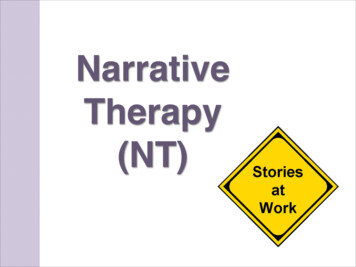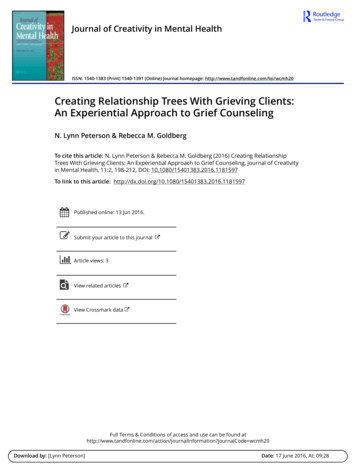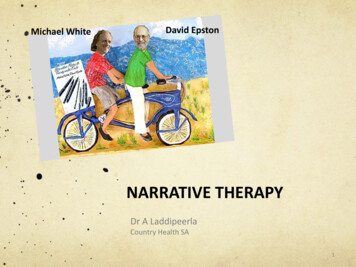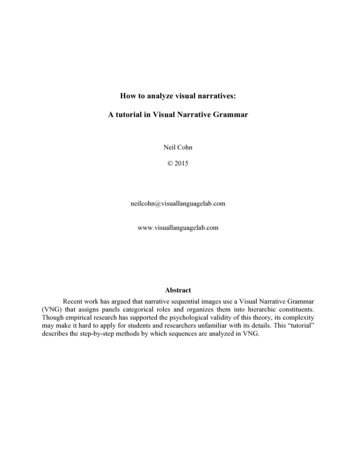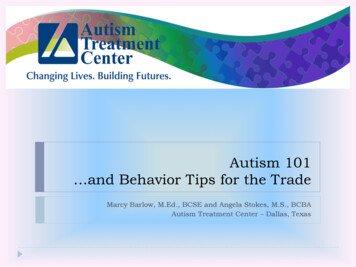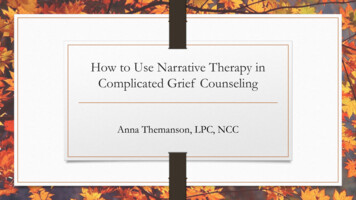
Transcription
How to Use Narrative Therapy inComplicated Grief CounselingAnna Themanson, LPC, NCC
Illinois Counseling AssociationFoundation
Definitions Bereavement “Bereavement is an objective fact” (as cited in Weaver, 2010, pg 10) Grief Reaction to the death of a loved one Mourning Cultural response to bereavement and grief, what one does to copeKastenbaum, R. J. (1998). Death, Society, and Human Experience (6th ed., Rev.). Needham Heights, Mass.: Viacom.Weaver, J. (2010). Narratives from grief counseling: Client perspectives on effective interventions and strategies for recovery. Retrieved ntent.cgi?article 1111&context edc theses
Definitions Complicated grief Intensified and prolonged grief that results in severe impairment in functioning(Weaver, 2010) Chronic grief, exaggerated grief Bereavement exclusion for major depressive disorder (APA, 2013) Clinicians can diagnose MDD after the loss of a loved one, previously not allowed eventhough symptoms paralleled MDDAmerican Psychiatric Association. (2013). Diagnostic and statistical manual of mental disorders (5th ed.). Washington, DC: American Psychiatric Publishing.Weaver, J. (2010). Narratives from grief counseling: Client perspectives on effective interventions and strategies for recovery. Retrieved ntent.cgi?article 1111&context edc theses
American Psychiatric Association. (2013). Diagnostic and statistical manual of mental disorders (5th ed.). Washington, DC: American Psychiatric Publishing.
American Psychiatric Association. (2013). Diagnostic and statistical manual of mental disorders (5th ed.). Washington, DC: American Psychiatric Publishing.
Issues and Concerns of Complicated Grief Severe impairment in functioning (Mayo Clinic, 2014)Strained personal relationshipsExtreme avoidance of relics of the deceasedWithdrawn from friends, family, activitiesLost sense of purpose or meaningIntense focus and attention on the death of the loved oneMayo Clinic. (2014). Complicated grief. Retrieved from licated-grief/basics/symptoms/con20032765
Reconstructing Meaning Critical component to processing grief and mourningHuman beings must construct meaning in order to understand experiences (Neimeyer, 1999)Constructivist view rejects “universality” of grief and focuses on individual implicationsConversations help remember and identify meaning of said life for continued connection(Hedtke & Winslade, 2004) Caregivers help by navigating decisions with bereaved in amending their narratives(Neimeyer, 1999) Negotiated in a social context, grounded in reality (Neimeyer, 200) Tacit and embedded meaning, permission for client to retain privacyHedtke, L., & Winslade, J. (2004). Re-membering lives: Conversations with the dying and the bereaved. Amityville, NY: Baywood Publishing Company.Neimeyer, R. A. (1999). Narrative strategies in grief therapy. Journal of Constructivist Psychology, 12, 65-85.Neimeyer, R. A. (2000). Searching for the meaning of meaning: Grief therapy and the process of reconstruction. Death Studies, 24, 541-558.
Why Narrative Therapy? Clients are empowered and have active role in ‘re-writing’ their story Journey is as important as the product (Neimeyer, 2000) Relies on own skills and abilities Allows client healthy distance from pain without complete avoidance (Good Therapy, 2016) Externalization of problem Serving vs. harming Dominant storylines influence decision making Some own authority of their stories, while others observe stories that are enforced for them(Neimeyer, 1999).GoodTherapy.com. (2016). Narrative therapy. Retrieved from es/narrative-therapyNeimeyer, R. A. (1999). Narrative strategies in grief therapy. Journal of Constructivist Psychology, 12, 65-85.Neimeyer, R. A. (2000). Searching for the meaning of meaning: Grief therapy and the process of reconstruction. Death Studies, 24, 541-558.
Interventions Life Imprint (Neimeyer, 1999) Acknowledge and recognize how the loved one influenced our lives Story Mountain (Patsy Way) (as cited in Neimeyer, 2012) Beginning, problem peak, resolution, ending Provides opportunity for multiple voices and can instill hope Find Your Voice (Gail Noppe-Brandon) (as cited in Neimeyer, 2012) Client writes play that externalized problems but is cathartic to share Client finds normalcy in feedback from actors Loss timeline (Alison J. Dunton) (as cited in Neimeyer, 2012) Provides opportunity for clients to recall previous similar situations to identify strengthsNeimeyer, R. A. (1999). Narrative strategies in grief therapy. Journal of Constructivist Psychology, 12, 65-85.Neimeyer, R. A. (2012). Techniques of grief therapy. New York, NY: Routledge.
Interventions Metaphoric Images (Neimeyer, 1999) Describing our loss in analogies and metaphors to increase understanding of event Journaling (Neimeyer, 1999) Allows deep insight that may not be addressed during session Focus on traumatic lossWrite what you rarely say aloudFlow between objective facts and subjective reactionWrite for 15 minutes/day for four or more days without care for proper grammarEase back into daily activity after journalingNeimeyer, R. A. (1999). Narrative strategies in grief therapy. Journal of Constructivist Psychology, 12, 65-85.
The Virtual Dream (Neimeyer, Torres, & Smith, 2011)A traumatic deathA crying childAn empty houseA mountainA talking animalA sunriseNeimeyer, R. A., Torres, C., Smith, D. C. (2011). The virtual dream: Rewriting stories of loss and grief. Death Studies, 35:7, 646-672.
Neimeyer, R. A., Torres, C., Smith,D. C. (2011). The virtualdream: Rewriting stories ofloss and grief. Death Studies,35:7, 646-672.
Neimeyer, R. A., Torres, C., Smith,D. C. (2011). The virtualdream: Rewriting stories ofloss and grief. Death Studies,35:7, 646-672.
Conclusion Constructing meaning is essential in working through grief and mourningBe collaborative and do not have expectationsRespect clients privacy and hesitancy (Neimeyer, 1999)Integrate homeworkNarrative therapy is empoweringNeimeyer, R. A. (1999). Narrative strategies in grief therapy. Journal of Constructivist Psychology, 12, 65-85.
ReferencesAmerican Psychiatric Association. (2013). Diagnostic and statistical manual of mental disorders (5th ed.). Washington, DC: American PsychiatricPublishing.GoodTherapy.com. (2016). Narrative therapy. Retrieved from es/narrative-therapyHedtke, L., & Winslade, J. (2004). Re-membering lives: Conversations with the dying and the bereaved. Amityville, NY: Baywood Publishing Company.Kastenbaum, R. J. (1998). Death, Society, and Human Experience (6th ed., Rev.). Needham Heights, Mass.: Viacom.Mayo Clinic. (2014). Complicated grief. Retrieved from licatedgrief/basics/symptoms/con-20032765Neimeyer, R. A. (1999). Narrative strategies in grief therapy. Journal of Constructivist Psychology, 12, 65-85.Neimeyer, R. A. (2000). Searching for the meaning of meaning: Grief therapy and the process of reconstruction. Death Studies, 24, 541-558.Neimeyer, R. A. (2012). Techniques of grief therapy. New York, NY: Routledge.Neimeyer, R. A., Torres, C., Smith, D. C. (2011). The virtual dream: Rewriting stories of loss and grief. Death Studies, 35:7, 646-672.Weaver, J. (2010). Narratives from grief counseling: Client perspectives on effective interventions and strategies for recovery. Retrieved ntent.cgi?article 1111&context edc theses
Definitions Bereavement “Bereavement is an objective fact” (as cited in Weaver, 2010, pg 10) Grief Reaction to the death of a loved one Mourning Cultural response to bereavement and grief, what one does to cope Kastenbaum, R. J. (1998). Death, Society, and Human Experience (6th ed.,
